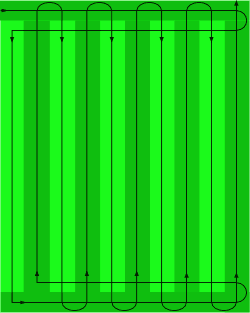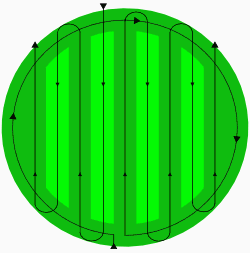Home › Garden lawns › Mowing a lawn
Mowing A Lawn
Mowing a lawn may be your least favourite gardening job. But one thing's for certain - it needs to be done!
How you go about it, and how often, depends on whether it is a high quality or a utility lawn (more information on this at lawn grasses), how it is used, the time of year and, of course, the weather.
The right tools make the job much easier, so, if you haven't already, read the tips on choosing the best lawnmower and find out which other lawn care tools you will need.
Why is it important to mow your lawn?
If done correctly, mowing a lawn is the most important method of keeping it in good condition.
Frequent light mowing (removing no more than a third of the leaf length) encourages a dense healthy lawn and deters weed growth.
Tip: Little and often is the key to success - infrequent mowing with the blades set too low will eventually weaken the grass and encourage weeds and moss.
Mowing a Lawn: When should you mow?
Mowing is normally carried out from early spring to late autumn.
Although lawn grasses will grow during very mild spells in winter, the first cut is not usually needed until early spring. From this point growth will continue until it tails off in late autumn.
There is generally a peak of particularly rapid growth during early summer and you may need to mow more frequently during this period.
If there is a spell of very wet weather, try to delay mowing as wet grass will clog the blades.
In frosty spells mowing will damage the grass so wait for milder conditions.
Mowing a Lawn: How often should you mow?
Spring and Autumn
In spring and autumn mowing once a week should be sufficient for both high quality and utility lawns.
Summer
In summer, utility lawns can be cut once a week, whilst high quality lawns may need up to three cuts per week to keep them in good condition and looking their best.
Bear in mind that the weather can have a dramatic effect on growth rate. Mild damp spells produce a flush of growth and, if this happens, you may need to increase the frequency of cuts.
Dry periods, on the other hand, may result in no growth at all and the formation of dry brown patches. If this happens stop mowing until conditions improve and your lawn recovers.
Mowing a Lawn: How short should you cut?
The length of cut can be adjusted by raising or lowering the blade height on your lawn mower and should be varied through the growing season with the longest cuts in spring and autumn, and the shortest in summer when growth is at its strongest.
Avoid cutting so low that you 'scalp' the lawn as this weakens the grass and allows weeds and moss to become established.
High Quality Lawns
The grasses used in high quality lawns can withstand very short cuts. In spring and autumn cut down to 1cm. In summer you can go as low as 8mm.
Utility Lawns
Utility lawns should be kept rather longer because the types of grasses used do not tolerate very close cutting. The extra length also protects the lawn from heavy wear.
In spring and autumn cut to approximately 2.5cm. In summer, provided growth is strong, you can cut as low as 1.5cm.
Mowing a Lawn: How do you make stripes?
If you want to achieve a smart striped effect on your lawn you will need to use a lawn mower with a rear roller.
The diagrams below show the different techniques for either square and rectangular lawns, or circular and irregularly shaped lawns.
Square and Rectangular Lawns

If your lawn is square or rectangular, start by mowing a broad strip at each end. This will give you room to manoeuvre the mower at the end of each run. Then mow up and down in straight lines.
Make sure you overlap your lines slightly so that all the grass gets mown.
Tip: When you've finished, and are ready to put your lawnmower away, take care not to push it back across the lawn or you will end up with a stripe that you didn't intend to be there!
Circular and Irregular Lawns

If you have a circular or irregular lawn, begin by mowing a strip all around the edge. Then position yourself at the bottom edge and mow a strip up the centre line. Continue mowing up and down to the edge.
Now reposition yourself at the top edge, alongside your centre line strip, and mow the other half of the lawn.
Tip: It can sometimes be difficult to keep your lines straight on an irregular shaped lawn, so pick out a feature beyond the lawn that you can use as a guide and push the mower straight towards it.
Mowing a Lawn: The Finishing Touches
Once you've finished mowing, trim the edge of the lawn using a pair of long handled edging shears or a strimmer, and then check that all the grass clippings have been removed from the surface.
Now... sit back and enjoy!
Need More Information?
For more information about lawns you can get an overview of the subject, together with links to other lawn-related pages, at garden lawns.
Home › Garden lawns › Mowing a lawn
